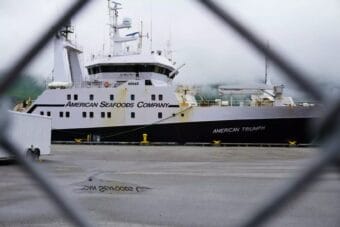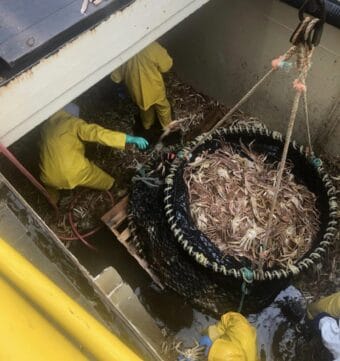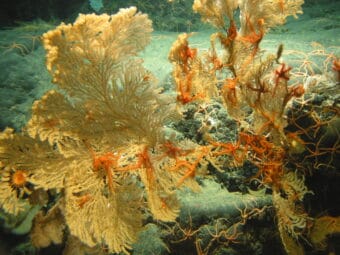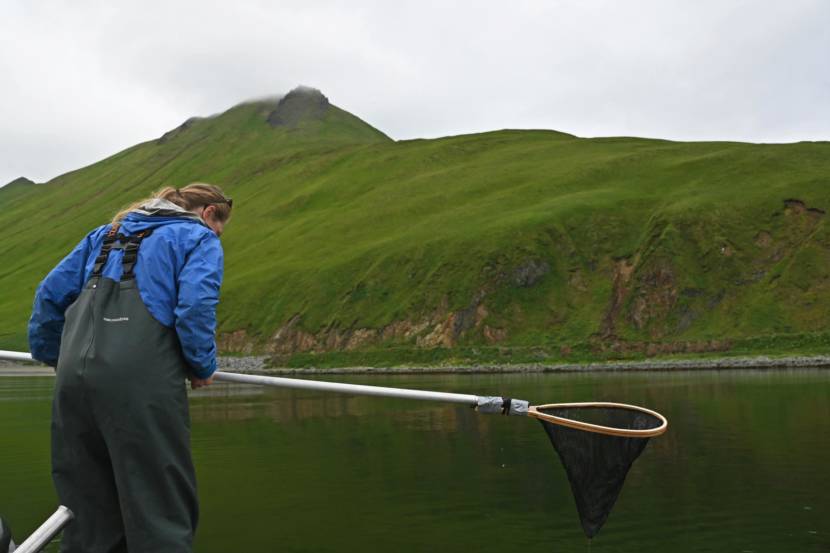
Paralytic shellfish poisoning, caused by eating seafood contaminated with toxins from harmful algal blooms, can be deadly to humans. Now, using marine samples from Unalaska, scientists are trying to understand if those harmful algal blooms could also be responsible for seabird die-offs.
There’s not much data on how saxitoxin — a harmful compound produced by algal blooms that cause PSP — spreads through the larger food web. But in July, a group of biologists with the United States Geological Survey visited Unalaska to collect samples of plants and animals in hopes of learning more about how saxitoxin levels magnify and diminish as they move through the food chain, from phytoplankton to mussels and up to seabirds.
“We don’t really know how this toxin moves through the food web,” said Sarah Schoen, a USGS wildlife biologist that recently collected marine samples in Unalaska. “There’s still a lot of unknowns, but the more information we can collect about it, the more we’ll understand it.”
Schoen said the project started about five years ago when a major heat wave, known as “the blob,” hit the ocean. Around the same time, there was a die-off of an estimated million common murres — a northern seabird — from Alaska down to California.
“When we picked up some of the carcasses, the birds were all starving; they were emaciated,” she said. “But we weren’t sure if there was another factor that was contributing to their deaths. So we became interested in knowing if something like toxins — biotoxins — could have contributed to their deaths.”
Schoen and other researchers collected tissue from the dead birds to test for saxitoxin and found some lower levels of toxins in about a third of the birds, but she said they weren’t sure what that meant for their overall health.
“It was still unclear if algal blooms — toxins — could have played a part in their death,” Schoen said. “The project has kind of expanded from there.”
Since then, she said they’ve also looked at tissues from live murres in breeding colonies and found that a similar proportion of birds had toxins, but the levels were lower.
Very little work has actually been done to look at the saxitoxin levels in seabirds, according to Schoen. Most people focus on intertidal invertebrates like mussels or clams and how those affect humans.
The extremely high toxin levels recently found in Unalaska make the island a good place for studying how the toxins travel up the food chain, specifically for learning when the levels may become deadly for animals that are further up that chain, like seabirds, Schoen said.
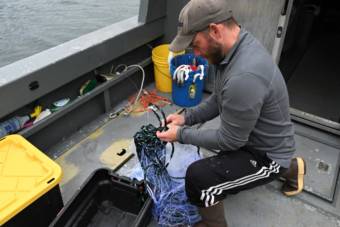
The U.S. Food and Drug Administration says it is safe for humans to consume meat with up to 80 micrograms of toxin per 100 grams of tissue. Around the beginning of July last year, some samples of blue mussels collected in Unalaska showed toxin levels that were more than 100 times higher than that. And in June of this year, some sampling showed toxin levels of more than 6,000 micrograms per 100 grams of tissue.
“Those are levels that make us interested in what’s going on with the whole food web,” Schoen said.
Schoen and her team want to discover if these toxins play a role in the recent record-breaking bird deaths and to see whether they transfer to seabirds in higher levels or not.
Sometimes it can be tricky to trace samples back to a singular, specific algal bloom, but she said it was easy to make those connections in this recent sampling in Unalaska.
“In this case, everything looks to be super connected,” Schoen said. “The mussels are filtering in the plankton that we’re collecting right offshore. Fish are eating the plankton. The birds are eating the fish, and they’re all in the same system.”
Schoen and her colleague Daniel Donnelly — another biologist on the team — collected samples of various fish including sand lance, Pacific sandfish, cod and halibut, as well as species of seabirds like horned puffins and black-legged kittiwakes.
They only had about a day to collect the samples, and Donnelly said finding all of the animals, coordinating and setting the different gear and properly recording everything made for a hectic day.
“We got samples from different trophic levels, meaning all the way from zooplankton to small plankton, foraging fish to predator fish, to birds — so a whole bunch of different levels in the ecosystem,” he said.
Donnelly is an avid hunter and shot some of the live birds to bring back to the lab to study. Others were collected from local fishermen who found and froze a dead puffin, for example, after a recent die-off.
Schoen said collecting and tracking data in a place like the Aleutians where there are few scientists can be tricky. But getting help from locals is a useful way to keep track of marine behavior and things like strange die-offs.
She said people can call the Alaska Marine Mammal Stranding Network or contact the Alaska Harmful Algal Bloom Network if they notice something strange.
She added that they’re hoping to have some of the samples from this trip analyzed by the end of this year.
